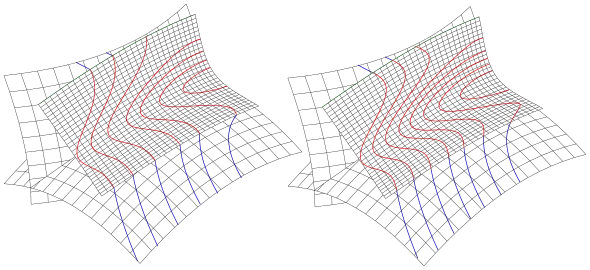Isophote
In geometry, an isophote is a curve on an illuminated surface that connects points of equal brightness. One supposes that the illumination is done by parallel light and the brightness is measured by the following scalar product:

is the unit normal vector of the surface at point and the unit vector of the light's direction. In case of , i.e. the light is perpendicular to the surface normal, point is a point of the surface silhouette looked in direction . Brightness 1 means, the lightvector is perpendicular to the surface. A plane has no isophotes, because any point has the same brightness.
In astronomy, an isophote is a curve on a photo connecting points of equal brightness. [1]
Application and example
In computer-aided design, isophotes are used for checking optically the smoothness of surface connections. For a surface (implicit or parametric), which is differentiable enough, the normal vector depends on the first derivatives. Hence, the differentiability of the isophotes and their geometric continuity is 1 less than that of the surface. If at a surface point only the tangent planes are continuous (i.e. G1-continuous), the isophotes have there a kink (i.e. is only G0-continuous).
In the following example (s. diagram), two intersecting Bezier surfaces are blended by a third surface patch. For the left picture, the blending surface has only G1-contact to the Bezier surfaces and for the right picture the surfaces have G2-contact. This difference can not be recognized from the picture. But the geometric continuity of the isophotes show: on the left side, they have kinks (i.e. G0-continuity), and on the right side, they are smooth (i.e. G1-continuity).
 Isophotes on two Bezier surfaces and a G1-continuous (left) and G2-continuous (right) blending surface: On the left the isophotes have kinks and are smooth on the right
Isophotes on two Bezier surfaces and a G1-continuous (left) and G2-continuous (right) blending surface: On the left the isophotes have kinks and are smooth on the right
Determining points of an isophote
on an implicit surface
For an implicit surface with equation the isophote condition is
That means: points of an isophote with given parameter are solutions of the non linear system
which can be considered as the intersection curve of two implicit surfaces. Using the tracing algorithm of Bajaj et al. (see references) one can calculate a polygon of points.
on a parametric surface
In case of a parametric surface the isophote condition is
which is equivalent to
This equation describes an implicit curve in the s-t-plane, which can be traced by a suitable algorithm (see. implicit curve) and transformed by into surface points.
See also
References
- J. Hoschek, D. Lasser: Grundlagen der geometrischen Datenverarbeitung, Teubner-Verlag, Stuttgart, 1989, ISBN 3-519-02962-6, p. 31.
- Z. Sun, S. Shan, H. Sang et. al.: Biometric Recognition, Springer, 2014, ISBN 978-3-319-12483-4, p. 158.
- C.L. Bajaj, C.M. Hoffmann, R.E. Lynch, J.E.H. Hopcroft: Tracing Surface Intersections, (1988) Comp. Aided Geom. Design 5, pp. 285–307.
- C. T. Leondes: Computer Aided and Integrated Manufacturing Systems: Optimization methods, Vol. 3, World Scientific, 2003, ISBN 981-238-981-4, p. 209.
- J. Binney, M. Merrifield: Galactic Astronomy, Princeton University Press, 1998, ISBN 0-691-00402-1, p. 178.